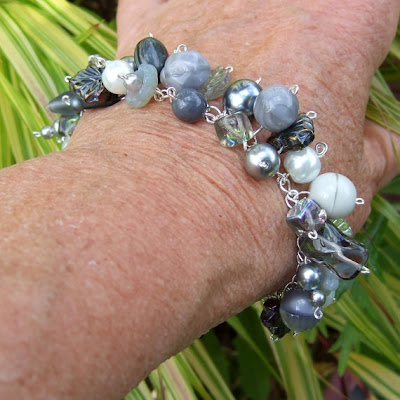Ideas on how to make your own boxes
I needed boxes for my jewellery and found it difficult to find any that filled my requirements...and at the right price!
I decided to have a go at making my own....
I happened to have this card making equipment..until now unused!
...with this you can score accurate fold lines.
I used 160 gms card, which is OK for small boxes, I did make double folds all round to give more stability.
The last side to be folded in, I secured the flaps down with double sided tape.
Close up of the corner cuts.
I designed and printed some labels for the lids.
Lid completed ...don't forget to make them a few mm's larger than the base!
Lid and box complete
I lined the box with tissue.
Ready to send or give...
You can make any size with this idea, square or rectangular. Line it with fabric, tissue or patterned papers.Decorate the box lid ....so many possibilities!
Recycled card in several weights and a good selection of colours from https://secure.eco-craft.co.uk/acatalog/index.html
I found a wonderful selection of tissue papers on this site http://www.thewrappingranch.co.uk/
and other goodies on both sites!!!
Let me know your comments!
HAPPY NEW YEAR!
Life in Ireland and Morocco....unique artisan jewellery, clothing and crafts....food and travel
Sunday, 30 December 2012
Wednesday, 12 December 2012
Wearing my Artists Hat
Back to the future
Before I started making jewellery, I painted......I shall go back to it again...in the future!
Each month I will post a few of my paintings.
I live near the River Barrow in Ireland and most of this series of paintings are on the Barrow or the Nore.
TIME and TIDE
These were all acrylic on canvas
Before I started making jewellery, I painted......I shall go back to it again...in the future!
Each month I will post a few of my paintings.
I live near the River Barrow in Ireland and most of this series of paintings are on the Barrow or the Nore.
TIME and TIDE
 | ||
| An old working barge |
 |
| Lock Gates |
 |
| Salmon Cots |
 |
| River Rushes |
 |
| High and Dry |
 |
| Boats under bridge |
Saturday, 8 December 2012
Sunday, 2 December 2012
Corsets, Crinolines and Codpieces.Part 3.Extremes of Fashion
Hennins and Footwear
The renaissance was well known for its extremes of fashion, perhaps the oddest woman’s headdress was known as the hennin,worn mainly in Northern Europe.
The hennin was a cone of stiffened material sometimes metal, covered with sumptuous cloth. It was worn balanced on the head with a light veil hanging from the point often woven in gold, this veil also sometimes framed the face.
Isabella of Bavaria wore a hennin 30 cms in length,covered with gold brocade and studied with precious stones, the veil covered her shoulders and back. In France the doorways in the Castle of Blois had to be enlarged to allow the court ladies to pass through without stooping.
.....and some mens hats
...And some shoes or Poulaines
At the Battle of Nicopolis in 1396, French Crusaders were forced to cut off the tips of their poulaines in order to be able to run away.
Part 4...Codpieces.....watch this space!
Part 2 of Corsets, Crinolines and Codpieces
Fashion is Born
The array of different
hat shapes in this picture shows the extraordinary variety of head wear of the renaissance period.
| from Les Tres Riches Heures du Duc de Berry |
The renaissance was well known for its extremes of fashion, perhaps the oddest woman’s headdress was known as the hennin,worn mainly in Northern Europe.
The hennin was a cone of stiffened material sometimes metal, covered with sumptuous cloth. It was worn balanced on the head with a light veil hanging from the point often woven in gold, this veil also sometimes framed the face.
Isabella of Bavaria wore a hennin 30 cms in length,covered with gold brocade and studied with precious stones, the veil covered her shoulders and back. In France the doorways in the Castle of Blois had to be enlarged to allow the court ladies to pass through without stooping.
Different shapes of
hennin
 |
| Workshop of Rogier van der Weyden, Portrait of a young woman of the Burgundian gentry wearing a "beehive" or perhaps truncated cone hennin, 1460s. Part of the veil comes forward to cover the eyebrows. |
 |
| Isabella of Portugal, Duchess of Burgundy in a divided hennin. Copy of original of 1445–50. |
 |
| Maria Portinari of Bruges wearing a high but still truncated hennin with a veil hanging from the top and black lappets or (possibly) underhood, 1476–78. |
.....and some mens hats
 | ||||||||||
| Philip the Good, Duke of Burgundy, wears an elaborately draped chaperon with a black-on-black figured silk short overgown with width at the shoulder, 1447–48 |
_with_frame.jpg) | ||
| A chaperon worn in elaborate twists, 1433 |
Sometimes the point of the shoe (
the "poulaine") would need support from a whalebone or a string tied to the leg just below the knee to
stop the point getting in the way when walking.The points were stuffed with mo ss or hemp.
Outdoors patterns
or sandal-like clogs were usually worn underneath to keep the shoes from mud and wet.
Laws attempted to define by class how long
shoes could be - the nobility were to be allowed two foot-lengths, merchants
one, and peasants one half.
Like other attempts to control fashion by legislation, these seem to have
failed.At the Battle of Nicopolis in 1396, French Crusaders were forced to cut off the tips of their poulaines in order to be able to run away.
 |
| Mediaeval Poulaines recovered from the Thames |
 | |
| Poulaines worn in Burgundy ca. 1470 |
 | |
| Worn with spurs from the Columbia Triptych |
Part 2 of Corsets, Crinolines and Codpieces
Fashion is Born
Subscribe to:
Comments (Atom)















